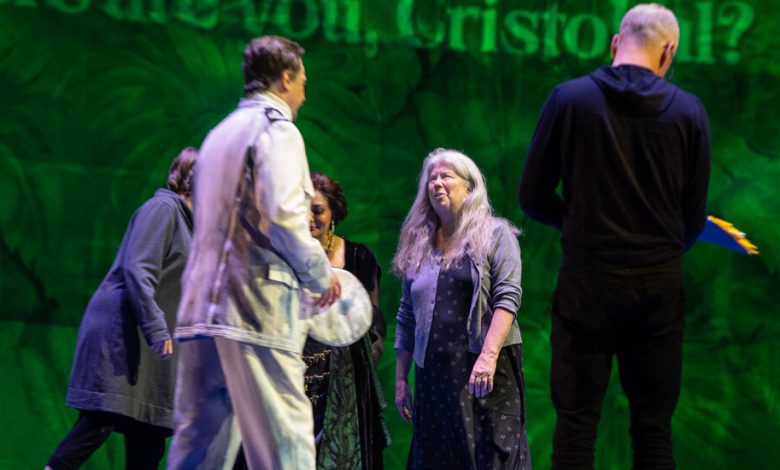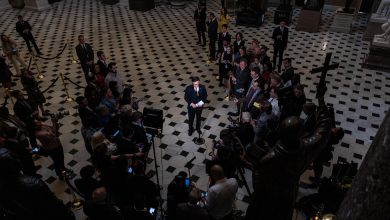An Opera’s Riverboat Journey Brings the Rainforest Onboard

There really was no reason for Mary Zimmerman to get stuck while directing her new production of “Florencia en el Amazonas,” which premieres on Thursday at the Metropolitan Opera.
The staging is her sixth for the Met, and at first glance, the work looked to be square in her wheelhouse. Her storytelling often has a dreamlike quality, and here was an opera suffused with poetic oneirism and the magical realism of Gabriel García Márquez: the tale of a diva traveling incognito on an Amazonian riverboat ostensibly to perform in Manaus, a city nestled deep in the rainforest, but really to try to reunite with her missing lover and muse, the butterfly hunter Cristóbal.
Yet when time came to start conceptualizing her production, Zimmerman found herself stalling. The fit was maybe too perfect.
“I’m quite a bit overidentified with Florencia,” Zimmerman said after a recent rehearsal. “I am single, and I kind of lost the great love of my life because I couldn’t stop doing theater, and I couldn’t be smaller than I was. A lot of us performers and artists with broken hearts, partly everything we put on is for that person, whether they’re going to see it or not.”
Zimmerman eventually got over her bout of director’s block, to mount a milestone for the Met: Daniel Catán’s work, with a libretto by Marcela Fuentes-Berain, is the company’s first by a Mexican composer. A vehicle for the soprano Ailyn Pérez, the production will also be conducted by the Met’s music director, Yannick Nézet-Séguin.
“Florencia” is almost entirely set on the boat, and most productions, starting with Francesca Zambello’s premiere staging at Houston Grand Opera in 1996, have made the ship a scenic centerpiece. But Zimmerman turned her gaze outward. “I wanted to emphasize the natural world and the outdoors,” she said. At the Met, the focus will be on what the passengers see during their journey rather than on their mode of transportation.
That shift of emphasis is in accordance with Catán’s score, Nézet-Séguin said. “I’ve never been in the Amazon, but any forest you first go in, it just looks like a bunch of trees and leaves the same color, then you spend a few minutes, open your eyes and there’s a million details,” he added. “I feel like this piece is this way.”
Amazonian flora and fauna were a fruitful source of inspiration for the creative team, especially the costume designer Ana Kuzmanic: Even the striking outfits and headpieces that symbolize the spread of cholera were drawn from the opera’s setting. “We discovered there’s this type of bird in the Amazon called the harpy eagle, so that’s what they’re based on,” Zimmerman said. “Originally, they were just like straight-up Venetian masks, but then we made them more like the animal.”
The costumes also represent physical elements like the ever-present water, at one point with the summoning of figures representing waves. “I honestly feel the blue waves are the best water costuming I’ve ever seen,” Zimmerman said. “Because representing water onstage, other than using water, is hard. It’s changeable, it’s moving all the time.” (She should know: Her breakthrough came in 2001 with a Tony Award-winning staging of Ovid’s “Metamorphoses” that involved an actual pool. She also tackled opera’s most famous pond with “Rusalka” at the Met in 2017.)
To Zimmerman’s delight, Catán’s score even includes musical interludes in which she could let her imagination run free. “My favorite is the three-and-a-half-minute one, which I call ‘night into day,’ or we sometimes call it ‘the creature ballet,’” she said of a scene that involves a bottle containing wedding rings. “We just love watching it and working on it.”
For Nézet-Séguin, the playfulness and fluidity of Zimmerman’s staging feel like an answer to Catán’s score. “The orchestration is very inventive,” he said. “It’s, of course, evoking the nature with the birds and the noise of the forest, but it’s also very well developed in terms of adopting the general flow of the piece, which is never static. I feel like he’s so good at suggesting a constant wave, like a river or like the ocean, or any body of water, that’s never stopping.” (Catán, who died in 2011, embraced a neo-Romantic style and often has been compared to Puccini.)
Just as the landscapes change over the course of Florencia’s trip, so do the travelers — the discoveries are as emotional as they are visual. “So much is transforming and changing throughout the opera,” Zimmerman said. “Florencia sort of finds her true identity by shedding her famous identity, and there’s a kind of dissolution into the natural world, I think.”
Pérez also described the opera’s journey as more than physical. “It almost becomes a subplot of a much more spiritual and community story, with a sense of humor and a sense that the destination is about enjoying the journey,” she said, “reflecting on choices and choosing love and viewing death as a rebirth into another life.”
In a sense, working on “Florencia” has also meant a trip back to Pérez’s own roots. The Met hasn’t presented a Spanish-language opera in nearly a century, and Pérez, born in Chicago to Mexican immigrants, is thrilled to finally sing in the language she spoke at home as a child. “It’s not even the Castilian Spanish of Spain but Mexican Spanish, Latin American Spanish,” she said, “so I don’t have to be corrected over how I say my words for the first time in my life.”
That feeling of connection, both to one’s self and to the surrounding world, makes “Florencia” a fitting addition to the Met’s efforts at greater inclusivity in recent years. For Nézet-Séguin, it’s important “to have alternative possibilities on our stage, alternating moods or ways of thinking about life,” he said. “And clearly this opera has a lot of humor, sometimes a little dry humor, sometimes more playful, and I see the production is adapting to this very much.”
Zimmerman is definitely on board, so to speak, with that view. “You want to support and lift and entertain the audience,” she said. “My motto is: Never a dull moment, and always be blossoming.”




